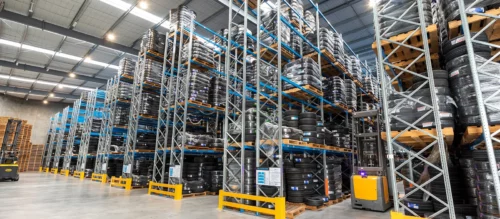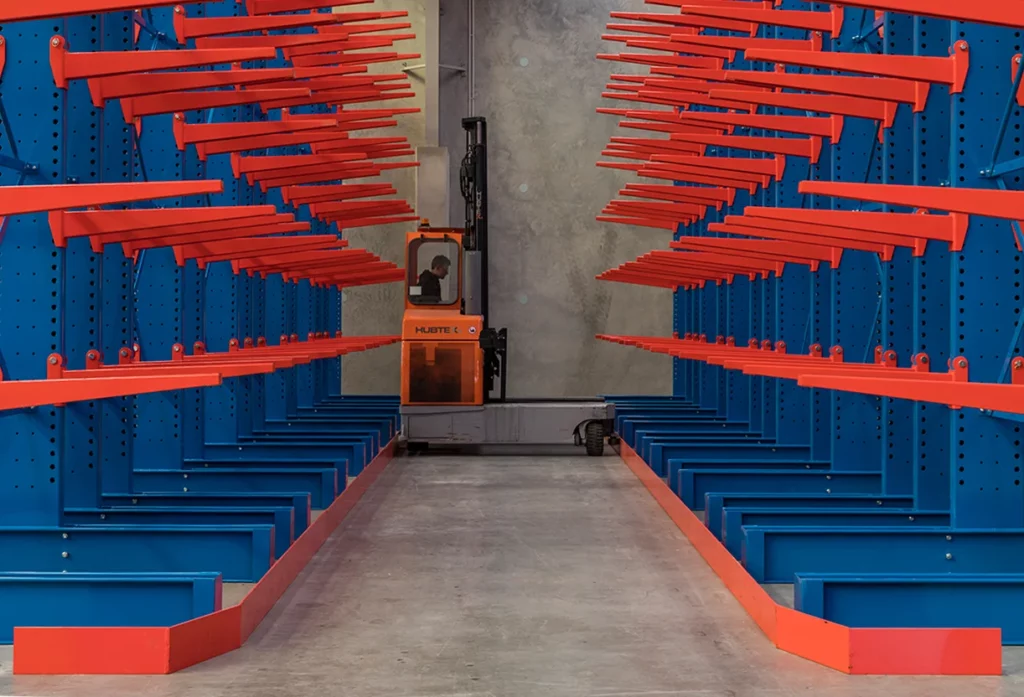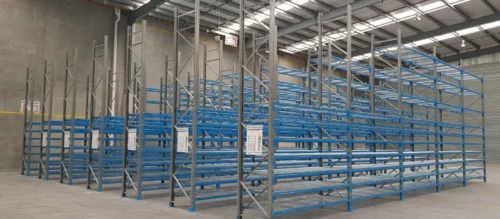If you run a warehouse or a storage business and need to know what pallet racking is, then you are in the right place. Pallet racking is a system that allows for efficient storage and organization of goods in a warehouse or storage facility. It consists of various parts and accessories that work together to create a structure that can hold and store pallets filled with products.
Pallet racking offers many benefits for businesses, including maximising space, increasing productivity, and making inventory management easier. In this blog post, we will delve into the basics of pallet racking to help you understand this essential asset in any industrial or logistics environment.
What is Pallet Racking?
Pallet Racking is a storage system designed to store products on pallets. Utilising vertical space, it allows for the efficient storage of large quantities of goods while maintaining easy access to each pallet. Primarily seen in commercial and industrial settings, the primary purpose of a pallet racking system is to maximise space, increase storage density, and improve the productivity of a warehouse operation.
This is accomplished by creating an organised system that allows for the rapid identification, access, and retrieval of individual pallets. Consequently, the use of pallet racking leads to improved inventory management and can significantly reduce the time and labour costs associated with handling goods.

Pallet Racking Systems: Maximising Storage Space and Improving Accessibility
Pallet racking systems are ingenious in their ability to maximise storage space. Rather than elongating your storage footprint horizontally, these systems capitalise on the vertical space within a warehouse.
By stacking pallets high, they drastically increase the volume of goods that can be stored in a given area. This vertical stacking approach is a significant space-saver, making it a cost-effective solution for businesses with limited warehouse space.
Moreover, pallet racking systems are designed to improve accessibility significantly. In most cases each pallet within the racking system can be independently accessed, without the need to shift other pallets.
This provides a considerable advantage in warehouse operations, as it facilitates quick and easy picking of items, reduces handling time, and minimises the risk of damage to goods.
Additionally, the organised nature of the racking system allows for better inventory control, as each pallet’s location can be precisely recorded and tracked. This efficient system ensures a smooth workflow and enhances overall productivity within the warehouse.
Types of Pallet Racking Systems
There are numerous types of pallet racking systems available, each designed to meet specific needs and warehouse configurations.
Selective Pallet Racking
It is the most common type used and is typically built in configurations of one or two-deep pallets. It provides easy and direct access to every pallet, making it an excellent choice for warehouses that need to store a wide variety of products on different pallets.
Drive-In Racking systems
These are designed for high-density storage. With this system, pallets are placed so they can slide backwards on a rail, thus storing them more deeply and reducing the amount of aisle space needed.
This type of racking system is ideal for storing large quantities of similar goods that can be loaded and unloaded in a last-in, first-out (LIFO) manner.
Push-Back Racking
It is a type of pallet storage system that allows pallets to be stored on both sides of an aisle, providing higher capacity storage. This pallet rack system uses a dynamic rail system, whereupon each newly added pallet pushes the others back along the rails, hence the name “push-back” racking.
When a pallet is removed, the rest slide forward. This system allows for more variety in product selection but is best used with a last-in, first-out (LIFO) inventory system.
Cantilever Racking
Cantilever racking is a unique type of racking that is specifically designed for the storage of long and bulky items such as timber, pipes, and sheet boards. Unlike common pallet racking systems, cantilever racking has arms that extend from a single column, allowing for the storage of items of varying lengths without any vertical obstruction.
One of the key advantages of cantilever racking is its extraordinary flexibility. The adjustable arms can accommodate a wide range of lengths and sizes of materials, while the open-face design allows for easy access from a forklift or crane, thereby improving loading and unloading efficiency. Moreover, cantilever racking optimises the use of vertical space, thus maximising the storage capacity of your warehouse.

Cantilever racking also offers unparalleled durability. Built with high-quality materials and designed to withstand heavy loads, this system ensures long-term service and is an excellent investment for businesses dealing with large, bulky items. It’s also modular, allowing for easy additions or changes to the configuration as your storage needs evolve.
These are just a few examples of the variety of pallet racking systems available. Each type has its benefits and limitations, and the choice of which system to use would largely depend on the specifics of the warehouse operation.
Warehouse Pallet Rack Parts:
A pallet racking system is assembled using various parts. The primary parts include vertical uprights, horizontal beams, and MDF board or wire mesh decking. The vertical uprights are columns that hold up the weight of the pallets and distribute the load evenly throughout the system.
On the other hand, the horizontal beams are used as rails that support the weighty products, while the MDF board/wire mesh decks are placed on top of the beams and uprights to form a flat platform for supporting pallets and loose product.
Pallet Racking Accessories:
To improve the efficiency of a pallet racking system, some additional accessories can be included, such as pallet-support bars, upright protectors, mesh backing panels, and cable drum brackets.
Pallet-support bars are used for extra support under the pallets and make loading safer and easier. Furthermore, uprights protectors are designed to add protection to the upright against forklift damage, while mesh backing panels will help you create safe walkways around the racks, and cable drum brackets will allow you to store cable drums securely.
Extra Advice to set up your warehouse

Maximise Space: Pallet racking systems, with their vertical orientation and multiple horizontal levels, make optimal use of the vertical space often underutilised in warehouses, thus providing maximum bulk storage capacity.
Improved Accessibility: Pallet racking, by design, allows easy access to all pallets, ensuring efficient loading and unloading of goods. This leads to lowered handling time and increased productivity.
Enhanced Safety: Safety panels and robust pallet supports enhance the overall safety of pallet racking systems. Safety panels prevent items from falling off the pallet racks, and pallet supports ensure stable and secure positioning of stored goods.
Efficient Organisation: With pallet storage systems, goods can be neatly arranged and easily located, facilitating better inventory management and control.
Easy Expansion: Pallet rack uprights make the system easily expandable. As your storage needs grow, you can add more uprights and horizontal beams to increase storage capacity.
Versatility: Pallet racking systems are compatible with a wide range of pallet sizes and types, making them a versatile choice for various storage needs.
Durability: Made from high-quality materials, Pallet racking systems are built to withstand heavy loads and provide long-term service, making them a cost-effective storage solution.
Remember, the proper installation and maintenance of your pallet racking system are key to reaping these benefits and ensuring the safety and efficiency of your warehouse operations.
Pallet Racking FAQ
-
How high can I stack pallets on pallet racking?
Ans: The answer varies depending on pallet racking capacity, warehouse size, and any local fire compliance requirements.
-
How wide can my pallet racking be?
Ans: The maximum racking width depends on many factors, such as floor space, aisle width, type of pallet, and type and capacity of the forklift. Pallet racking is generally 900mm deep which allows for safe loading and storage of standard pallets.
-
What are the different types of pallet racking?
Ans: There are many types of pallet racking, but the most common include selective racking, double deep racking, drive-through racking, push back racking, and cantilever racking.
-
Is pallet racking safe?
Ans: When installed correctly, pallet racking is one of the safest storage methods in a warehouse. However, it is important to observe pallet rack guidelines such as weight capacity, unloading processes, and loading.
Conclusion
In conclusion, pallet racking systems offer an efficient and cost-effective solution for optimising the storage area in your warehouse or storage facility. When storing standard palletised products, these warehouse racking systems provide a specific, organised, and accessible place for each item.
This enhances the overall productivity and workflow, while significantly reducing the risk of damage to your goods.
Furthermore, pallet racking systems are not just limited to these materials. They are versatile storage solutions that can accommodate a wide range of goods, making them an essential asset in any industrial or logistics environment.
Remember, it’s not just about having a storage racking solution; it’s about having the right storage solution. Pallet racking systems certainly fit that bill.
